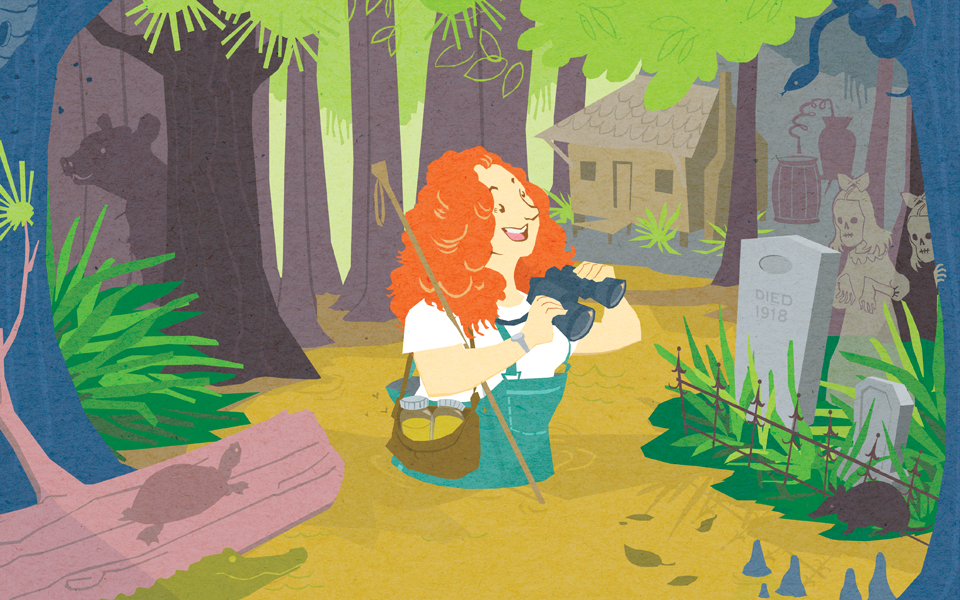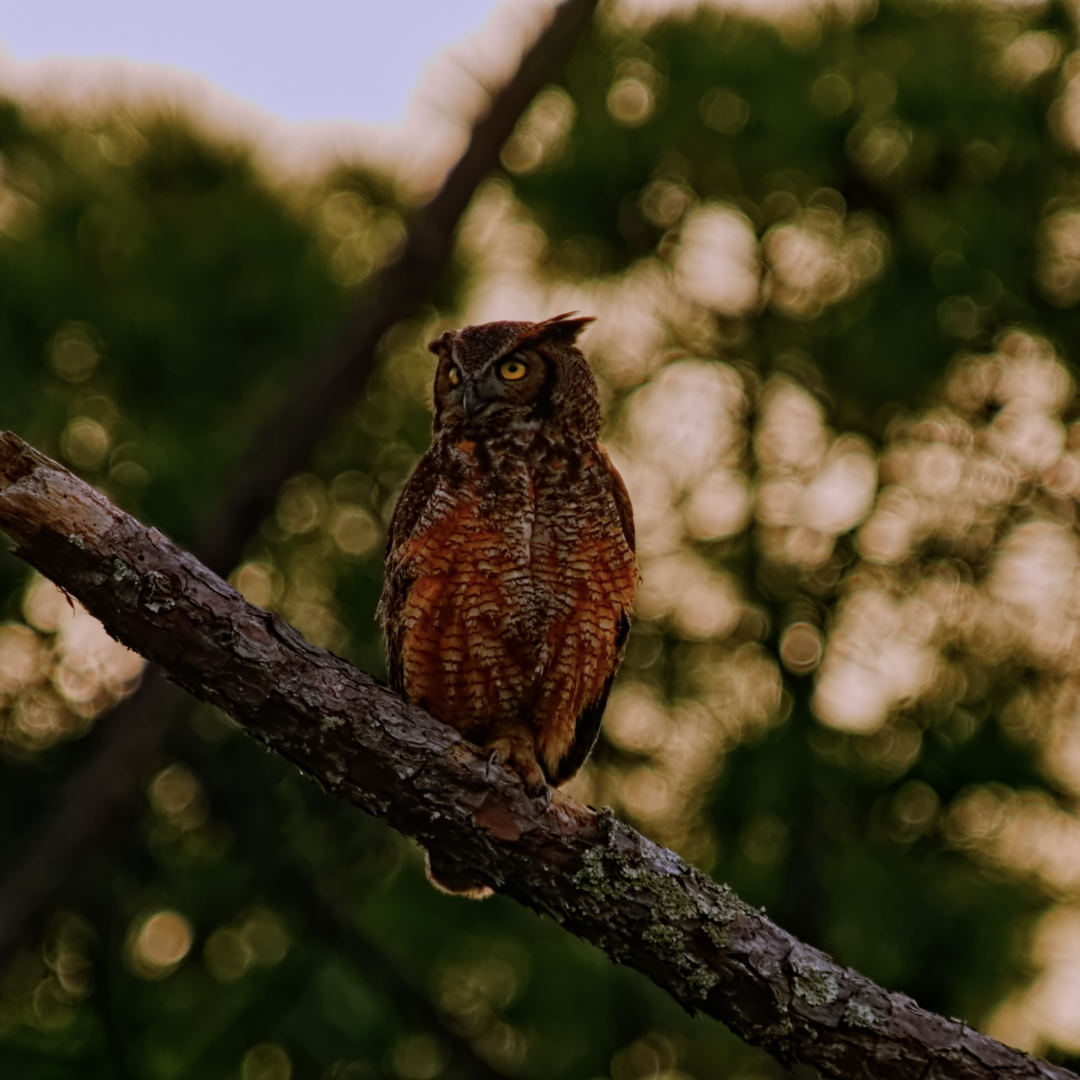by Diane Roberts | December 19, 2018
Swamp Sacraments
Diane Roberts wades in with the ghosts and gifts of her ancestral land

Some people have a family place on the beach; some people have a family house in the mountains. We have a family swamp. Our swamp is half land, half water, a tangle of bald cypress, sweet bay, possumhaw holly and three or four kinds of pines, a place of green shadows and owls conversing on hidden branches. It’s deep in Wakulla County, just off Smith Creek Road, a little north of Vause Branch, a little east of Mack Slough. Can’t find it on the map? Good. We like it that way.
When I was little, we used to drive down there from Tallahassee. Some of my uncles and cousins would be there. We’d stay for a few days in what was grandly referred to as my grandfather’s hunting camp. It was actually a house trailer, single-wide, with a lot of bunk beds and a window unit air conditioner that sounded like an idling Chevy Nova with a bad muffler.
In May, we’d fish in Mack Slough or take a johnboat to Mack Lake, where we’d watch ospreys swoop languidly while great blue herons stood impassively in the shallows. Come November, my uncles would hunt deer and wild hogs. The children would root around dead and lightning-struck longleaf pines for fragrant pieces of resin-rich heartwood to use in our fireplaces for the Thanksgiving and Christmas fires that, in our centrally heated houses, were more for atmosphere than for warmth. In the evenings, my grandfather, Edgar Lafayette Roberts, would tell stories about these two brothers who lived deep in the swamp. You had to pole a skiff to the cabin of the two “old boys” who wore overalls but never shirts underneath and kept a bear chained to their front porch. Or he’d tell about the two silent little girls in white dresses and big white hats who used to follow him on the path to the family burying ground, then disappear into the mist.
My grandfather kept a pen of relatively civilized pigs in a pen on a bluff above the slough, destined to become holiday hams, chops and spicy sausage. The wild hogs were likely descendants of the porkers from the Iberian Peninsula, brought over by Hernando de Soto in 1539, bred to thrive (or at least survive) in the indecent heat of southern Spain and Florida. My grandfather called them “conquistador hogs.” They mostly stayed in the deep woods, though sometimes they’d raid the camp, knocking over the metal drum full of feed corn meant for the penned pigs. My grandfather liked to scare us with stories of the viciousness of the conquistador hogs. He said their bite was worse than a bear’s, worse than a panther’s, worse than a mad dog’s. If you saw one coming, you’d best climb the nearest tree. I saw some conquistador hogs once, maybe 20 years ago. They were swimming the slough, six or seven of them, snouts held up out of the water, eyes dark and hard. I ran back to the road, locked myself in the car, and drove back to town.
I find that people don’t, in general, love swamps. In the popular imagination, swamps mean bugs. Snakes. Heat. Ravenous alligators people assume are longing for a taste of human flesh. In Florida, selling swampland to Yankee rubes who thought they were getting beachfront property was once a nice little moneymaker.
Then there’s the image of the swamp as a self-dealing ecosystem full of critters secretly stealing from more deserving animals. The current occupant of the White House speaks of “draining the swamp,” which shows what he knows about swamps. Come on, you say, when Trump says “drain the swamp,” he means D.C. insiders. But even lobbyists are part of the food chain, just like gators and snakes. While it would be nice to expel the pony-sized mosquitoes and some of the more irascible reptiles, you should never drain a swamp. You’ll wreck an important habitat. Plus, swamps act as filtration systems, cleaning the gunk before the water seeps down into the aquifer.
When I was about 5, I fell off the bank into the slough. I’m told I was fishing. What I remember is the water churning with the writhing bodies and glittering eyes of water moccasins all around me. My father jumped down and pulled me out by my hair. Everybody was screaming—except the vipers.
Like what you read? Subscribe to Flamingo.
But even vipers belong at Smith Creek. They’ve been there far longer than we have. My great-great-grandfather, Richard Roberts, supposedly did not fear any snake crawling on the earth. He was a mysterious character, only appearing in official records in 1862, when he joined the Fifth Florida Infantry Company C. He fought at Antietam; he fought at Fredericksburg. He survived—barely—the Siege of Petersburg. He was wounded and, in 1864, went home to Florida. There’s no court-admissible evidence for this, but family legend tells that he convalesced with the family of his friend, Redden Smith, at Smith Creek. In September 1866, Richard Roberts married Redden’s sister, Ellen Jane Smith, whose daddy owned a fair bit of land along the Ochlockonee River, some of it high enough to farm. Three of Richard and Ellen’s six children lived past infancy, Theophilus, Edwin, and my grandfather’s father, Valerious Lafayette Roberts. Twin girls born in 1867, Sarah and Jane, died only a few months old. They’re buried in graves lined with oyster shells on high ground near a stand of longleaf pines. Sometimes, my grandfather thought Sarah and Jane were the ghost girls he used to see on the graveyard trail; other times he says it was his two young cousins who died in the 1918 influenza epidemic. I’ve walked that trail myself, at dusk, looking hard. I’ve never managed to catch sight of the little girls in white.
I’ve experienced other swamp mysteries. I’ve seen the white tupelo growing in the sloughs and creeks off the Ochlockonee River. “Tupelo” is a Creek word, which means something like “swamp tree.” In the spring, the trees are covered in tiny green-white blooms around a spheroid center, like exquisite little ringed planets, attracting clouds of delirious bees. Other kinds of tupelo trees grow in other parts of the world—China, Mexico, Central America—but this species, named for Ogeechee River in southeastern Georgia, is the only source of the famous honey. In the 1770s, the naturalist William Bartram made a drawing of a white tupelo, its roots curling down into the water, as he explored the Southeast.
It takes 2 million tupelo flowers to produce one pound of honey, a miracle of swamp transubstantiation. A third-generation Wakulla bee man, probably a distant cousin of ours (it’s hard to keep track), keeps his hives on our land and pays “rent” in honey.
When the case of bright gold honey arrives, I take out a jar and dip up a spoonful. Unlike my grandfather, his grandfather, and beyond, beginning with a tight knot of families that formed in 1825 when my first ancestors traveled from what is now Nassau County to the brand new territorial capital in Tallahassee, then turned south to where the trees grew thickest, I have never lived off the land. My father left Wakulla County and became a civil engineer with a house on a hill far above the danger of rising rivers. Yet the sweetness of that honey transports me, as though I’m communing with all those Smiths and Vauses, Tuckers and Robertses who made their home deep in the watery woods—a sacrament of the swamp.





